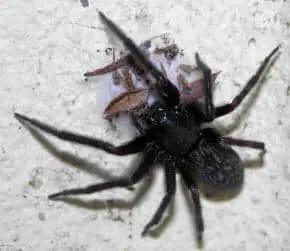The Black House (or window) spider is found in most of Australia including Tasmania and has been introduced into New Zealand. It likes dry temperature and is more common inland. The Scientific name for the Black House spider is Badumna Insignis.
The description of the Female is up to 18mm long and the Male is only 9mm. This spider has a strong build and is coal – black or dark brown. They also often have a row of faint white V’s on their back. The head -(Thorax) is shiny black and the eyes are in two rows of four. The Black House spider comes from the family Pesidae, it is a species of lace web-making spider.
Table of Contents
HABITAT
The Black House Spider can be found in rock crevices on loose tree bark, sheds, cracks in brick walls and in window corners. They normally take up permanent residence in sheltered exterior corners of almost any wooden or brick structure. A favourite site is the corner of a window, the web radiating outwards. They can also found in cracks in fibro, rusting corrugated iron, ventilators and other places commonly visited by insects.

In the natural bush land. The Black House Spider often builds its snare in unhealthy trees. The web may appear tunnel like with one or more entrances. They are “typical” colourless, lacy, tangled, shawl-like structures. The web often has two or three funnel like entrances leading to a silky retreat where the spider rests in the daytime. The Black House Spider use the rakes on its hind legs to pull the silk from its spinning plate and spinnerets, When the web is first made it has a bluish tingle. The web consists of a series of radiating threads with zigzag threads crossing between them like the rungs of a ladder and are usually heavily embroidered. The Black House Spider can be found in dry areas throughout Australia and Tasmania.
PREY
Black House Spider a wide variety of insects, and other spiders. If can be seen resting in a corner of it’s snare or in the retreat tunnel, with forelegs stretched out along the web. When the insect becomes tangled in the web and struggles the spider receives the vibrations through sensory hairs set in sockets on its forelegs. The spider grasps the threads of the snare with its claws and tugs sharply at rapid intervals in a reflex action produced by the female muscles. This tugging action entangles struggling insect, which is swathed in silk, bitten, dragged into the funnel and consumed in safety. It may eat the insect then or wrap it up with its silk thread for later.
BREEDING
A female Black House Spider wraps her eggs in a flat white silk egg sac. She hides the sac in her web or near a nearby crevice. The mother guards the sac until the spiderlings hatch. Each spiderling produces milk thread’s, which are caught by the wind and carry the young spiders away.
VENOM
The venom of the Black House Spider is poisonous but not lethal, it can cause much harm to humans. Bites are rare and usually occur when people attempt to move the web.

BIBLIOGRAPHY
1. Australian Spiders in colour, Ramon Mascord, Chatswood NSW, 2067, 1970
2. The Puffin Book of spiders, Helen Hunt, Australia, 1982
3. Australian Animals spiders, Greg Pyers, Victoria, 1999
4. Spider watch, Bert Brunet, Australia, 1996
5. Photo: Qld Museum
Two photos above copyright: Dan Baldry
Photos below of the black house spider copyright Dragan
The Black House Spider is not usually aggressive and they will bite only if they are annoyed. The bite may cause vomiting, nausea, heavy sweating, breathing problems, muscular pain, however their symptoms are only temporary.
Click here for more photos of Black House Spiders.
Information and pictures were taken from children’s projects and where credited to that child does not claim to be original information. Where possible, permission to reproduce has been sought. Any infringement of copyright is purely unintentional.





